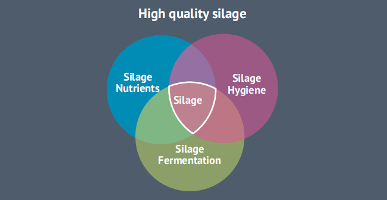- Home
- Resources
- Animal Health and Welfare
- Animal Health Guides
- Silage and Health
Silage and Health
Silage and Health – Improving animal health, welfare and profitability
High qualitysilage is not just about the nutrient value and the fermentation quality but should also consider the hygienic quality. All aspects are important to improve animal health, welfare and profitability. The diagram shows high quality silage where all three aspects have been considered and approaches made to ensure all three aspects are controlled. The area in the centre of the diagram indicates the high value.

What is meant by hygienic quality? It is the silage components that can have an effect on animal health. High hygienic quality silage is free from disease causing microorganisms or their toxic end-products. The microbiology of forage and silage is extremely complex. There are many microorganisms present in the farm environment, both in the field and the yard most of which are undesirable and can and do contaminate silage.
Details of the micro-organisms that can be found in silage and can potentially cause disease in livestock can be found in the booklet ‘Silage and Health’. The booklet also outlines good practices to avoid these micro-organisms getting into silage.
Moulds can have an effect on animals directly through the spores being inhaled and causing lung diseases through exposure over a long time. The main livestock health risk from fungi and moulds in forages is from the secondary end-products they produce, namely mycotoxins. They are harmful at very low levels some at concentrations of even less than 1 part per million (less than 1 mg/kg DM). In silage they can occur even when there is no visible mould, conversely when mould is present it does not necessarily mean mycotoxins will be present.
Mycotoxins can form either in the crop before the silage is made or in the silage after it has been made. The mycotoxins produced in the field will survive the ensiling process and are the mycotoxins that can be present in silage where there is no visible mould.

Where mould is visible then there is always the risk of storage formed mycotoxins, produced by Penicillium or Aspergillus. There are well over 200 different types of mycotoxins present in nature, the vast majority of which are not routinely measured. They are produced by a wide range of different fungal species and under different environmental conditions.

The common mycotoxins found in silage are Zearalenone, Deoxynivalenol and T2 toxin and they cause a range of problems such as internal bleeding and problems for the liver or nervous system. The first symptom is likely to be a reduction in feed intake and animals may have diarrhoea and look lethargic.

If you suspect that the silage being fed has caused a health problem in your livestock stop feeding, isolate those animals in case there is a risk of the infection being passed to other stock and consult your vet for the best course of action.
